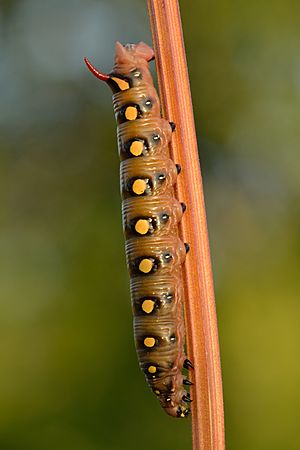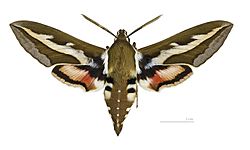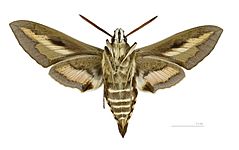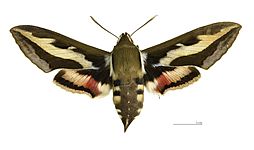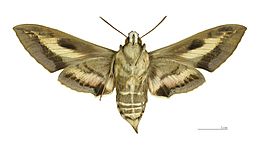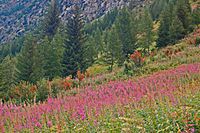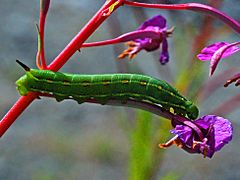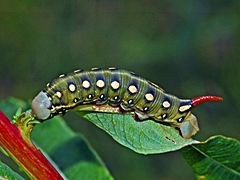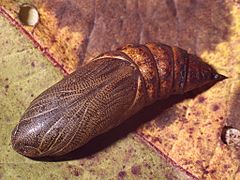Bedstraw hawk-moth facts for kids
Quick facts for kids Bedstraw hawk-moth |
|
|---|---|
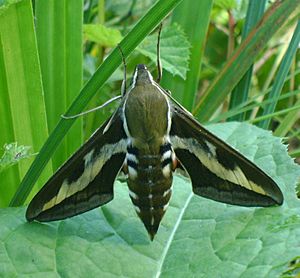 |
|
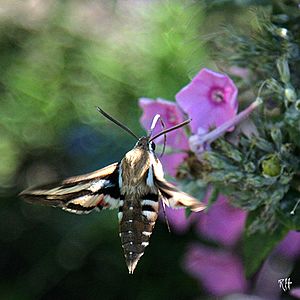 |
|
| Feeding | |
| Scientific classification |
The Bedstraw hawk-moth (scientific name: Hyles gallii) is a type of moth from the Sphingidae family. It is also known as the galium sphinx. This moth was first described by S. A. von Rottemburg in 1775.
Contents
Where the Bedstraw Hawk-Moth Lives
The Bedstraw hawk-moth can be found in many parts of the world. It lives in North America, across Europe (even up to the Arctic Circle), in Central Asia, and in Japan.
What the Bedstraw Hawk-Moth Looks Like
These moths are quite large, with a wingspan of about 55 to 80 millimeters. This is roughly the length of a credit card.
The Bedstraw hawk-moth looks a lot like another moth called the Spurge hawk-moth (Hyles euphorbiae). However, there are a few differences:
- The red color on the back wings of the Bedstraw hawk-moth is not as widespread.
- The olive-colored band on its front wings is a continuous line, not broken up.
Detailed Description of the Moth
The front wings of the Bedstraw hawk-moth are olive-brown. They have a wide, uneven, whitish stripe running down the middle.
The back wings are black near the body. Then, there's a wide band that starts pinkish-white and becomes bright pink in the middle. After that, there's a clear black band, followed by a grey edge.
The moth's chest and body are olive-brown. There's a white line on each side of its chest, right where the wings begin. This line continues along each side of the head, just above the eye. The sides of the body have black and whitish spots.
What the Caterpillar Looks Like
The caterpillar of the Bedstraw hawk-moth is smooth. It can be bluish-green on top and pink underneath. Sometimes, it's brown or even black.
No matter its main color, it always has a pale, almost yellow, line down the middle of its back. It also has ten clear, eye-like yellow spots on each side. The caterpillar's head matches its body color (green, brown, or black). However, the horn-like part above its tail is always red.
The caterpillar eats in August and September. It then turns into a pupa.
The Chrysalis
The chrysalis (which is like a cocoon for moths) is brown. It is usually found hidden in the sand. The adult moth then comes out around Midsummer.
Life and Habits
These moths are often seen at dusk, which is early evening. They fly around and feed on flowers. They are also active throughout the night and even into the daylight hours.
The Bedstraw hawk-moth usually flies from May to October. Most of the time, there is one main group of moths born each year. But in good years, there can be a second group.
Caterpillar Life
The caterpillars can grow quite long, reaching 70 to 80 millimeters. They come in different colors. One type is olive green with yellow spots. Another type is black with yellow spots and a red head. As the caterpillar gets ready to turn into a pupa, its color becomes darker.
The caterpillars eat various plants. Some of their favorite foods include fireweed (like Chamaenerion angustifolium and Epilobium montanum) and bedstraw plants (such as Galium verum and Galium mollugo). They can also eat other plants like Clarkia, Fuchsia, Circaea, and Plantago major. You can usually find these caterpillars from July to September.
Where They Live
The Bedstraw hawk-moth likes places that are sandy or have a lot of limestone. They enjoy sunny heathlands, plant farms, and warm edges of forests. Basically, they like any place where they can find the plants their caterpillars eat. These moths can even be found high up in the Alps, at elevations of up to 2700 meters above sea level.
Gallery
-
Caterpillar of Hyles gallii (young stage) on Epilobium angustifolium
See also
 In Spanish: Hyles gallii para niños
In Spanish: Hyles gallii para niños


